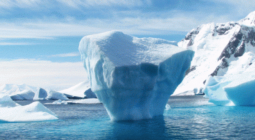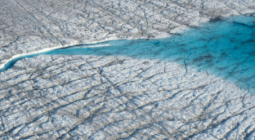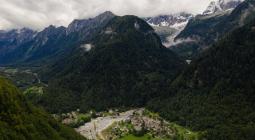How climate change is melting the Alps’ glaciers – in pictures
Most of the world’s mountain glaciers are retreating because of the climate crisis, but those in the European Alps are especially vulnerable. Smaller and with less ice cover, this year they are on track for their highest loss of mass in at least 60 years of record keeping
by Emma Farge and Gloria Dickie/Reuters. Photographs: Arnd Wiegmann/Reuters
From the way 45-year-old Swiss glaciologist Andreas Linsbauer bounds over icy crevasses, you would never guess he was carrying 10kg of steel equipment needed to chart the decline of Switzerland’s glaciers.
Normally, he heads down this path on the massive Morteratsch glacier in late September, the end of the summer melt season in the Alps. But exceptionally high ice loss this year has brought him to this 15 sq km (six sq mile) amphitheatre of ice two months early for emergency maintenance work.
The measuring poles he uses to track changes in the depth of the pack are at risk of dislodging entirely as the ice melts away, and he needs to drill new holes.
The Alps’ glaciers are on track for their highest mass losses in at least 60 years of record keeping, data shared exclusively with Reuters shows. By looking at the difference in how much snow fell in winter, and how much ice melts in the summer, scientists can measure how much a glacier has shrunk in any given year.
Since last winter, which brought relatively little snowfall, the Alps have sweltered through two big early-summer heatwaves, including one in July marked by temperatures near 30C (86F) in the Swiss mountain village of Zermatt.
During this heatwave, the elevation at which water froze was measured at a record high of 5,184 metres (17,000 feet) – an altitude higher than Mont Blanc – compared with the normal summer level of 3,000-3,500 metres.
“It’s really obvious that this is an extreme season,” Linsbauer said, shouting over the roar of rushing meltwater as he checked the height of a pole jutting out of the ice.
Most of the world’s mountain glaciers are retreating due to climate change. But those in the European Alps are especially vulnerable because they are smaller, with relatively little ice cover. Meanwhile, temperatures in the Alps are warming at about 0.3C a decade – twice as fast as the global average.
If greenhouse gas emissions continue to rise, the Alps glaciers are expected to lose more than 80% of their current mass by 2100. Many will disappear regardless of whatever action is taken now, thanks to global warming baked in by past emissions, according to a 2019 report by the UN Intergovernmental Panel on Climate Change.
Already, Morteratsch is much changed from the glacier depicted on the region’s tourist maps. The long tongue that once reached deep into the valley below has shrunk back by nearly two miles, while the depth of the snow and ice pack has thinned by up to 200 metres.
The smaller Pers glacier flowed into it until 2017, when it receded so much that it detached. However, glaciologists still often group them together with the Morteratsch complex.
The dire situation this year raises concerns that the Alps’ glaciers might vanish sooner than expected. With more years like 2022, that could happen, said Matthias Huss, who leads Glacier Monitoring in Switzerland (GLAMOSGlamos).
“We are seeing model results expected a few decades in the future are happening now,” Huss said. “I did not expect to see such an extreme year so early in the century.”
Glaciologists in Austria, France and Italy confirmed that glaciers there were on track for record losses. In Austria “the glaciers are snow-free up to the summits,” said Andrea Fischer, a glaciologist at the Austrian Academy of Sciences.
Seasonal snowfall, apart from replenishing ice lost during summer, protects glaciers from further melt by providing a white cover that reflects sunlight back out to atmosphere better than darker ice – sullied by dust or pollution – can do.
But at the Grand Etret glacier in north-west Italy, only 1.3 metres of snow had accumulated during this past winter – 2 metres less than the annual average for the 20 years up to 2020.
This year’s Alpine ice losses, registered even before the biggest melt month of August, surprised scientists to some extent as many of the glaciers had already lost their lower-lying snouts. Because they had retreated up the mountain, where temperatures are cooler, scientists thought they should have been better protected.
“You can easily imagine the final results after summer will be extensive loss of glacier coverage in the Italian Alps,” said Marco Giardino, vice-president of the Italian Glaciological Committee.
Data shared exclusively with Reuters shows that Morteratsch is now shedding about 5cm a day and is already in a worse state than it would normally be at the end of an average summer, according to data from Glamos and the Université libre de Bruxelles.
The nearby Silvretta glacier has lost about a metre more than at the same point in 1947 – the worst year in its database stretching back to 1915.





